CarderPlanet
Professional
- Messages
- 2,552
- Reaction score
- 712
- Points
- 83
Materials created in space for electronics are 100 times more efficient than existing ones.
British startup Space Forge is preparing to send a satellite into orbit to produce new semiconductor materials that can be used in electronic devices on Earth.
Space Forge lost its first experimental satellite during a failed launch of Virgin Orbit's LauncherOne rocket in the UK in January. The company's new satellite, ForgeStar-1, will soon travel to the United States for launch in late 2023 or early 2024, according to a Space Forge spokesperson.

Space Forge ForgeStar-1 Satellite
Recently, Space Forge signed a cooperation agreement with the American aerospace giant Northrop Grumman. Under the agreement, Space Forge will supply semiconductor substrates produced in space, which Northrop will then develop in its factories.
Space Forge explains that semiconductor materials are necessary for a variety of electronic technologies, but their production on Earth is expensive and requires a lot of energy. However, the vacuum and microgravity of space can allow the development of completely new semiconductor materials much more efficiently.
The production of complex semiconductors is a very intensive and slow process. They are literally grown from atoms. Gravity significantly affects production by changing the bonds between atoms. In space, this obstacle can be overcome, since there is no gravity, the company said.
In addition, an ideal space vacuum is necessary to protect sensitive material from contamination. On Earth, this vacuum is created artificially by industrial machines. The combination of microgravity and the vacuum of space allows researchers to create semiconductors that are "10 to 100 times more efficient than on Earth."
The microwave-sized ForgeStar-1 satellite contains a miniature automated chemistry lab that will allow the team to remotely mix various chemical compounds and develop new semiconductor alloys once the satellite is in orbit. However, instead of sending materials back to the planet, ForgeStar-1 will transmit the results of experiments to scientists in digital form, since the satellite is not designed to return to Earth.
Space Forge wants to create its next mission so that the satellite can survive re-entry through the atmosphere and deliver materials back to Earth. The company will focus not only on the production of semiconductors, but also on the development of medicines, composite materials and alloys. According to Space Forge, the first reusable return satellite could be launched in 2 or 3 years.
British startup Space Forge is preparing to send a satellite into orbit to produce new semiconductor materials that can be used in electronic devices on Earth.
Space Forge lost its first experimental satellite during a failed launch of Virgin Orbit's LauncherOne rocket in the UK in January. The company's new satellite, ForgeStar-1, will soon travel to the United States for launch in late 2023 or early 2024, according to a Space Forge spokesperson.

Space Forge ForgeStar-1 Satellite
Recently, Space Forge signed a cooperation agreement with the American aerospace giant Northrop Grumman. Under the agreement, Space Forge will supply semiconductor substrates produced in space, which Northrop will then develop in its factories.
Space Forge explains that semiconductor materials are necessary for a variety of electronic technologies, but their production on Earth is expensive and requires a lot of energy. However, the vacuum and microgravity of space can allow the development of completely new semiconductor materials much more efficiently.
The production of complex semiconductors is a very intensive and slow process. They are literally grown from atoms. Gravity significantly affects production by changing the bonds between atoms. In space, this obstacle can be overcome, since there is no gravity, the company said.
In addition, an ideal space vacuum is necessary to protect sensitive material from contamination. On Earth, this vacuum is created artificially by industrial machines. The combination of microgravity and the vacuum of space allows researchers to create semiconductors that are "10 to 100 times more efficient than on Earth."
The microwave-sized ForgeStar-1 satellite contains a miniature automated chemistry lab that will allow the team to remotely mix various chemical compounds and develop new semiconductor alloys once the satellite is in orbit. However, instead of sending materials back to the planet, ForgeStar-1 will transmit the results of experiments to scientists in digital form, since the satellite is not designed to return to Earth.
Space Forge wants to create its next mission so that the satellite can survive re-entry through the atmosphere and deliver materials back to Earth. The company will focus not only on the production of semiconductors, but also on the development of medicines, composite materials and alloys. According to Space Forge, the first reusable return satellite could be launched in 2 or 3 years.
